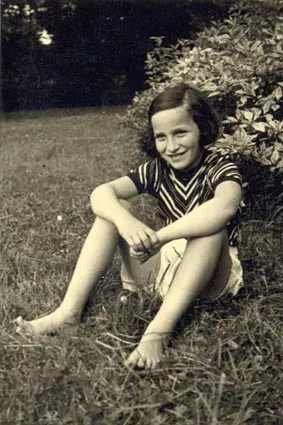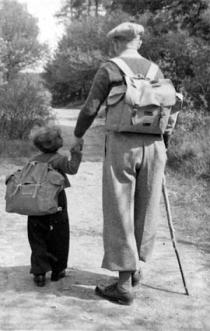This photograph is probably my first postwar one, and is from Kamenice.
One day a rumor began circulating in Terezin that the war was over. So we wanted to go to the end of the street, where the ghetto actually ended, but my mother didn’t want to let me go there. In the end we found out that the Russians hadn’t arrived yet, but that on the contrary it was the Germans as they were departing. They threw a hand grenade there, and it injured someone quite seriously. But then the Russians really did arrive, and Terezin really was liberated. But we remained in Terezin until the end of May, in quarantine.
I and my friend Stepka Sommer, the now already deceased cellist Rafael Sommer, and a handful of other children used to go to the garden, where our task was to air out the hothouse, water the plants and take care of refilling this big storage tank with water. It was a lot of fun for us, because we used to bathe in that large barrel, and after work we played excellent games in the garden. For that we’d get a head of lettuce, a kohlrabi or even a cucumber every day. After years of not seeing the smallest piece of fresh vegetable!
My first feeling of freedom is connected with a young soldier from the Russian army, who passed by the garden on a horse. We children were joyfully waving at him, and he came over to us, and pulled us up into the saddle with him, one after the other, and took us for rides. For me that was a truly fantastic feeling of liberation, when I was sitting with that young man on that horse and we were riding around in the Bohusovice basin. Our trip back to Prague was once again by train. I remember it, because my mother showed me Rip, a hill visible from far away, whose peak is at 465 m ASL, and that elephant in Sedlec again.
But we didn’t stay in Prague for long, because at that time Premysl Pitter already began organizing the ‘Chateaux’ drive for children that had returned from concentration camps. As an educator our mother couldn’t not participate, so she became one of the employees at the Kamenice chateau. We were among the first there. My mother began to mainly organize classes, because there were children of all age categories.
Back then my mother was tutoring children over a wide age range, because they needed to catch up on material from their relevant school grades over the summer. There weren’t classes all day. They were actually these little study groups, each one about two to three hours a day. But for my mother that meant at least five times two or three hours a day. In the meantime we played and went on walks, bathed and relaxed in all sorts of ways. I remember that swimming was the main attraction, because there were very nice ponds in the area, and up until then we’d never experienced real bathing. All we knew from Terezin was a battered enamel washbasin and once in a while, when it rained in the summer, we’d splashed about joyfully under the rainspout.




























